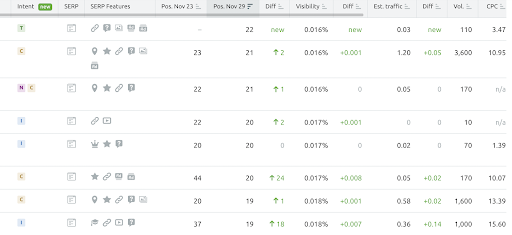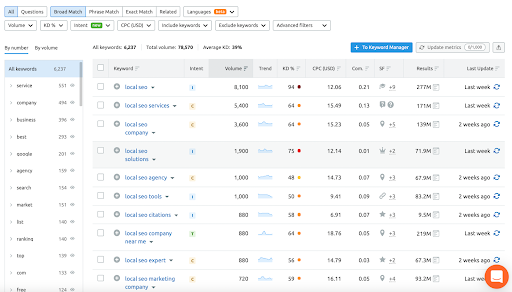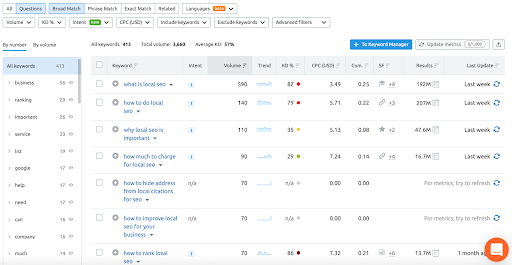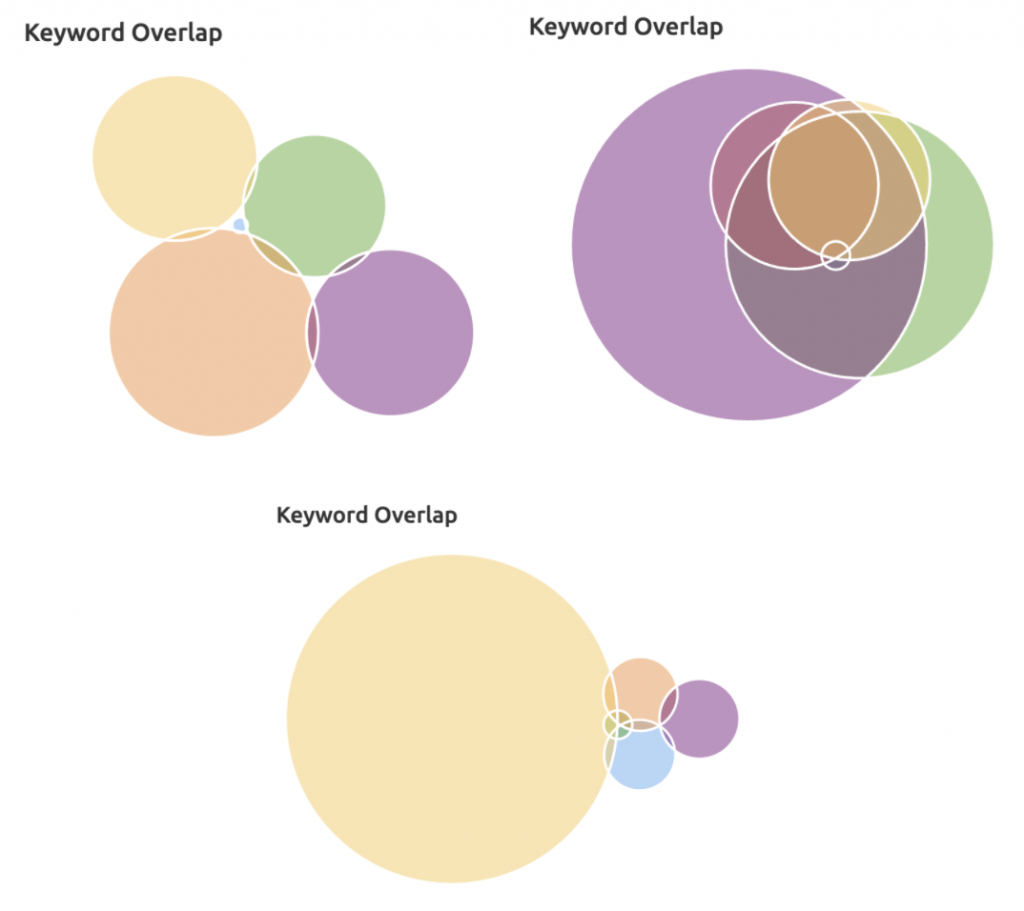Mar 31, 2022
Keyword research is a fundamental part of any content strategy. Whether it’s simply guiding on-page optimization efforts or informing the next quarter’s content roadmap, learning more about the terms your audience is using in real-time is a critical first step.
Keyword research helps tap into the collective consciousness of your audience and uncovers what’s most important to them.
Below, we explore how to create a content marketing strategy via three different ways to use Semrush for keyword research.
Get all the insight you need from Keyword Overview
Semrush’s Keyword Overview is a perfect entry point when evaluating a specific keyword. Within Keyword Overview, you can quickly evaluate search volume, intent, search features, and the competitive landscape for a particular search query.
There are four specific pieces of information we can immediately glean from the Keyword Overview tool:
- Search Volume: How often is this term being searched?
- How difficult is it to rank for this specific term?
- Does the search query get traffic in our target country demographic?
- Is the trend steady or growing?
It’s important to remember that search volume is an estimate of the average number of times a search query appears in Semrush’s database.
The New Intent Feature Helps You See How to Create a Content Marketing Strategy
Filtering keywords by search intent helps you find the most relevant keywords and the users most likely to lead to conversions.
You can now use Semrush to sort keywords by search intent, so you can find out how much engagement you can realistically expect from users typing in a given query, and whether a given query is right for a specific landing page.
Target search intent to find long-tail keywords that represent a high potential for conversion or organize only transactional, informational, commercial, or navigational keywords by various metrics, including search volume, CPC, and keyword difficulty.
Targeting search intent can lead to improved conversion rates, reduced bounce rates, and more featured snippets for your site on search results since your content will be directly engaging in the spirit of the user’s query.
The four main categories of search intent are:
- Informational intent — Users looking for an answer to a question.
- Navigational intent — Users looking for a specific site or page. Branded searches would be considered navigational.
- Commercial intent — Users looking to shop for products or services. These are future transactional users but are currently higher on the marketing funnel.
- Transactional intent — Users looking to complete a purchase or action.
Search intent can inform not only organic but also paid search and social ad strategies. While informational keywords might be targeted for brand awareness, commercial keywords would be targeted for content designed to nurture potential leads toward a conversion.
Search Features Can Help Uncover the Types of Content That Will Rank
Once you've identified target keywords, how to develop a blog content strategy starts with looking at the Search Engine Results Page (SERP) for your primary keyword. Does your target SERP contain shopping links? A local pack with a map? How about reviews? Videos? The way your target SERP looks should inform how you build your content.
The snippets featured on the results page can tell you a lot about how search engines view your keyword, and what kind of pages they are trying to serve for it.
Google’s rich results include featured snippets, local packs, site links, reviews, knowledge panels, videos, FAQs, and People Also Ask. These snippets are great ways to give your content more visibility on SERPs – and sometimes appear twice on page one for a search result. The result can lead to an improved click-through rate on one hand, and improve your credibility with a prospective customer on the other.
Local pack listings can be especially useful to any business with a brick-and-mortar location. Data shows that three-fifths of smartphone users have contacted businesses directly from search results, often from voice search queries for “near me” keywords.
Having a strong presence on local directories and tools like Google My Business can help your business show up on Local Pack snippets, along with the right SEO strategy.
You can target other Search Features – like Featured Snippets, FAQs, and People Also Ask – with the right FAQ schema. Just be sure to provide the most concise, clear response to the query, and check your schema with the Rich Results Test.
Keyword Magic Shows You How to Develop a Blog Content Strategy With Questions & Variants
The Keyword Magic tool is a great way to broaden the scope of your target keyword to long-tail variants and related questions (which likely appear in snippets on the SERP).
Below, view the top related queries for [local SEO].
You can break down searches by all related keywords, questions only, broad match, phrase match, and exact match, as well as filter for search volume, keyword difficulty, CPC, and more. Export the entire list and reorganize it with a metric that takes the factors you want into account for a comprehensive list of all the best potential targets related to your root keyword.
See the same list filtered for questions only below:
These questions represent opportunities to appear in the snippets on your target SERP – depending on which Search Features it contains. They’re also a great roadmap to guide future blog posts, on-page FAQs, and other common concerns from prospective leads.
Use Keyword Gap to Find Keywords from Competitors
A keyword gap analysis is only as good as the competitors you identify, but if executed correctly, it can yield a gold mine of untapped potential for your site.
Below, we see three different keyword gap results for three different sites with four identified competitors each.
In some cases, your site will have more overlap with some competitors than others. On the keyword list, “missing” keywords refer only to keywords where every other listed competitor has a presence, but your site does not. So the only site here with “missing” keywords is shown in the second graph.
Keywords that some competitors rank for that you don’t will show up under “untapped.” If there are overlaps with multiple competitors – but not all four – you can click on these overlaps to isolate those competitors only. At this point, you will see more keywords populate under the “missing” tab.
Diving into these keyword gaps and then filtering for Search Intent, Search Features, and other metrics like keyword difficulty, search volume, and CPC can produce a valuable list of potentially fruitful untapped opportunities for your site.
Search Competitors vs. Long-Term Competitors
It’s a good idea to repeat this exercise with multiple different types of competitors. On one hand, business owners might have lofty goals – big, industrial players in their niche that they’re trying to overtake. On the other hand, they may really come up against some small players in search results time and time again.
Repeat this exercise with long-term competitors to identify content opportunities for the future. Here, you may find more competitive search terms that you can work into your content plan and iterate until you start competing for terms with higher search volume and a higher level of difficulty.
However, pay attention to the players around your site. If there are some smaller sites that continue to show up as competitors within organic search results, take this as an opportunity to identify content gaps with those competitors. It may help unlock achievable organic search targets that pave a much quicker path for improving your organic visibility.
Overall, keyword research is a critical part of your organic search strategy, but it can be so much more. Keyword research helps you unlock content types that are crucial to meet the needs of your users. Good keyword research not only improves organic search but can also ensure you’re speaking the language of your customers in every marketing channel.





